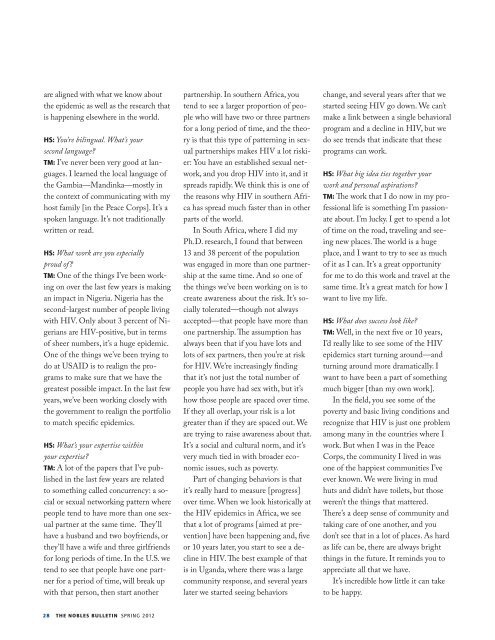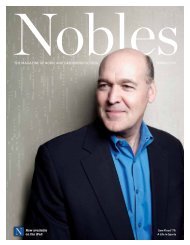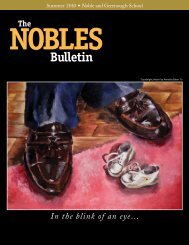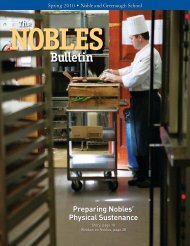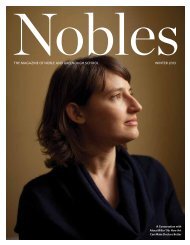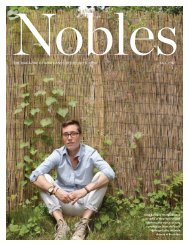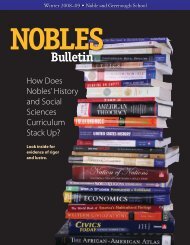B u l l e t i n - Noble and Greenough School
B u l l e t i n - Noble and Greenough School
B u l l e t i n - Noble and Greenough School
Create successful ePaper yourself
Turn your PDF publications into a flip-book with our unique Google optimized e-Paper software.
are aligned with what we know about<br />
the epidemic as well as the research that<br />
is happening elsewhere in the world.<br />
hs: You’re bilingual. What’s your<br />
second language?<br />
tm: I’ve never been very good at languages.<br />
I learned the local language of<br />
the Gambia—M<strong>and</strong>inka—mostly in<br />
the context of communicating with my<br />
host family [in the Peace Corps]. It’s a<br />
spoken language. It’s not traditionally<br />
written or read.<br />
hs: What work are you especially<br />
proud of?<br />
tm: One of the things I’ve been working<br />
on over the last few years is making<br />
an impact in Nigeria. Nigeria has the<br />
second-largest number of people living<br />
with HIV. Only about 3 percent of Nigerians<br />
are HIV-positive, but in terms<br />
of sheer numbers, it’s a huge epidemic.<br />
One of the things we’ve been trying to<br />
do at USAID is to realign the programs<br />
to make sure that we have the<br />
greatest possible impact. In the last few<br />
years, we’ve been working closely with<br />
the government to realign the portfolio<br />
to match specific epidemics.<br />
hs: What’s your expertise within<br />
your expertise?<br />
tm: A lot of the papers that I’ve published<br />
in the last few years are related<br />
to something called concurrency: a social<br />
or sexual networking pattern where<br />
people tend to have more than one sexual<br />
partner at the same time. They’ll<br />
have a husb<strong>and</strong> <strong>and</strong> two boyfriends, or<br />
they’ll have a wife <strong>and</strong> three girlfriends<br />
for long periods of time. In the U.S. we<br />
tend to see that people have one partner<br />
for a period of time, will break up<br />
with that person, then start another<br />
28 the <strong>Noble</strong>s bulletiN spring 2012<br />
partnership. In southern Africa, you<br />
tend to see a larger proportion of people<br />
who will have two or three partners<br />
for a long period of time, <strong>and</strong> the theory<br />
is that this type of patterning in sexual<br />
partnerships makes HIV a lot riskier:<br />
You have an established sexual network,<br />
<strong>and</strong> you drop HIV into it, <strong>and</strong> it<br />
spreads rapidly. We think this is one of<br />
the reasons why HIV in southern Africa<br />
has spread much faster than in other<br />
parts of the world.<br />
In South Africa, where I did my<br />
Ph.D. research, I found that between<br />
13 <strong>and</strong> 38 percent of the population<br />
was engaged in more than one partnership<br />
at the same time. And so one of<br />
the things we’ve been working on is to<br />
create awareness about the risk. It’s socially<br />
tolerated—though not always<br />
accepted—that people have more than<br />
one partnership. The assumption has<br />
always been that if you have lots <strong>and</strong><br />
lots of sex partners, then you’re at risk<br />
for HIV. We’re increasingly finding<br />
that it’s not just the total number of<br />
people you have had sex with, but it’s<br />
how those people are spaced over time.<br />
If they all overlap, your risk is a lot<br />
greater than if they are spaced out. We<br />
are trying to raise awareness about that.<br />
It’s a social <strong>and</strong> cultural norm, <strong>and</strong> it’s<br />
very much tied in with broader economic<br />
issues, such as poverty.<br />
Part of changing behaviors is that<br />
it’s really hard to measure [progress]<br />
over time. When we look historically at<br />
the HIV epidemics in Africa, we see<br />
that a lot of programs [aimed at prevention]<br />
have been happening <strong>and</strong>, five<br />
or 10 years later, you start to see a decline<br />
in HIV. The best example of that<br />
is in Ug<strong>and</strong>a, where there was a large<br />
community response, <strong>and</strong> several years<br />
later we started seeing behaviors<br />
change, <strong>and</strong> several years after that we<br />
started seeing HIV go down. We can’t<br />
make a link between a single behavioral<br />
program <strong>and</strong> a decline in HIV, but we<br />
do see trends that indicate that these<br />
programs can work.<br />
hs: What big idea ties together your<br />
work <strong>and</strong> personal aspirations?<br />
tm: The work that I do now in my professional<br />
life is something I’m passionate<br />
about. I’m lucky. I get to spend a lot<br />
of time on the road, traveling <strong>and</strong> seeing<br />
new places. The world is a huge<br />
place, <strong>and</strong> I want to try to see as much<br />
of it as I can. It’s a great opportunity<br />
for me to do this work <strong>and</strong> travel at the<br />
same time. It’s a great match for how I<br />
want to live my life.<br />
hs: What does success look like?<br />
tm: Well, in the next five or 10 years,<br />
I’d really like to see some of the HIV<br />
epidemics start turning around—<strong>and</strong><br />
turning around more dramatically. I<br />
want to have been a part of something<br />
much bigger [than my own work].<br />
In the field, you see some of the<br />
poverty <strong>and</strong> basic living conditions <strong>and</strong><br />
recognize that HIV is just one problem<br />
among many in the countries where I<br />
work. But when I was in the Peace<br />
Corps, the community I lived in was<br />
one of the happiest communities I’ve<br />
ever known. We were living in mud<br />
huts <strong>and</strong> didn’t have toilets, but those<br />
weren’t the things that mattered.<br />
There’s a deep sense of community <strong>and</strong><br />
taking care of one another, <strong>and</strong> you<br />
don’t see that in a lot of places. As hard<br />
as life can be, there are always bright<br />
things in the future. It reminds you to<br />
appreciate all that we have.<br />
It’s incredible how little it can take<br />
to be happy.


